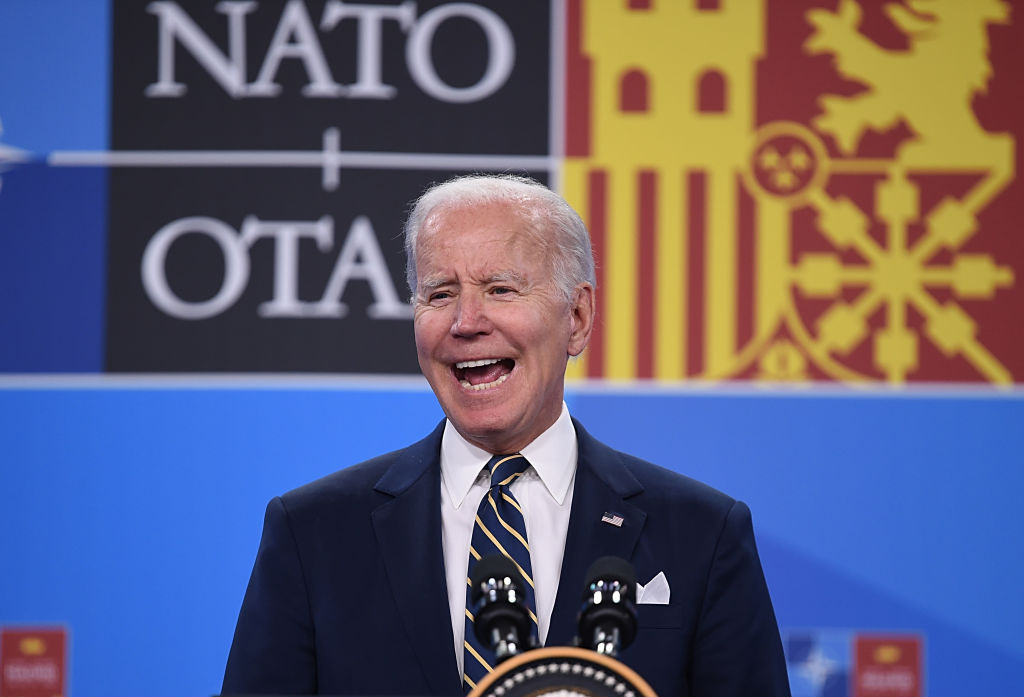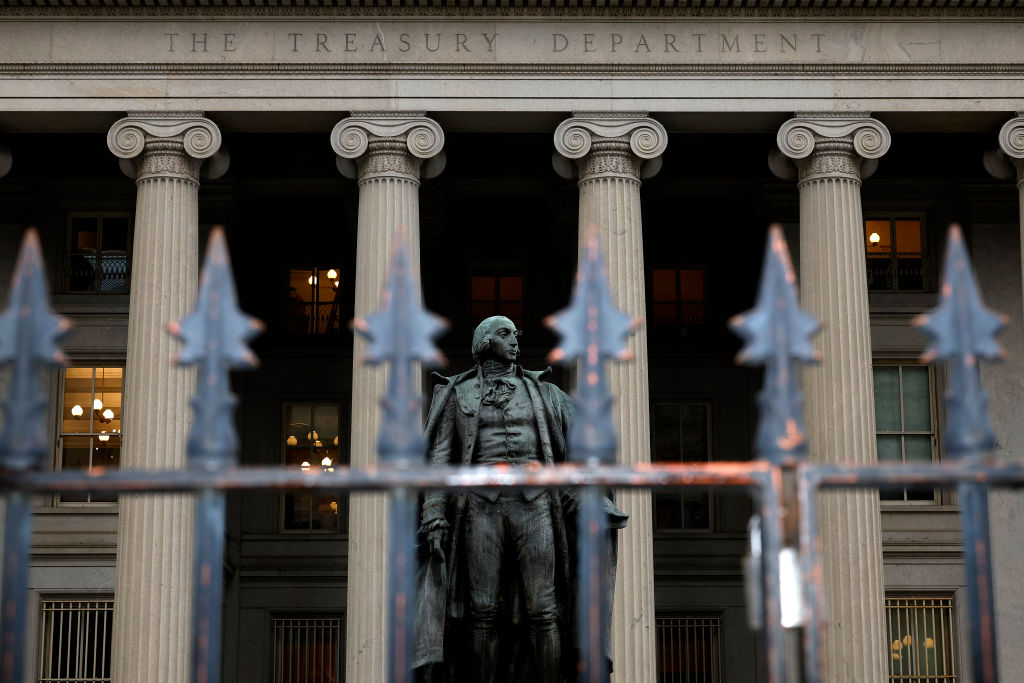His latest scandal is the capstone of an abysmal tenure.
Biden Plays Pretend

The President is economically illiterate, delusional, a liar, or all three about the probability and causes of a recession.
The Biden administration has huffed and puffed its adherence to progressive dogma and, as a result, it is about to blow down the American economy. The situation won’t improve until the Administration resolves its catalepsy.
In March, I described the substantial risk that America was heading toward a recession. A recession may already have begun, and it will certainly soon do so if the Biden White House does not immediately change course on energy and spending.
In June, U.S. and European economies slowed sharply as surging prices weakened demand. U.S. retail sales fell in May, and existing home sales have declined for four consecutive months. Economists surveyed by the Wall Street Journal put the risk of a recession in the next 12 months at 44 percent, a level usually seen only on the brink of, or during, recessions.
The classic definition of a recession is two consecutive quarters during which Gross Domestic Product (GDP) declines. The U.S. has just completed one quarter during which GDP declined at an annual rate of 1.5 percent. The Federal Reserve Bank of Atlanta is projecting a flat second quarter. If results tilt down by just one dollar, that would make two consecutive quarters of decline.
The National Bureau of Economic Research, a private, non-profit research organization that makes the official determination for the United States government, defines a recession as a “significant decline in economic activity that is spread across the economy and lasts more than a few months.”
NBER declared recent recessions in 2008, and 2001. It also declared that a brief recession commenced in February 2020, following Covid-19 lockdowns. Because NBER awaits a range of data to determine the start and end of a possible recession, it generally takes from four to 21 months after a recession commences or ends for NBER to make a determination.
The indicators of a recession I described in March have come to pass: rising interest rates (including the largest Federal Reserve rate increase since 1994), soaring inflation (now at the highest rate in 41 years), an inverted yield curve, and out-of-control federal borrowing. Supply chain problems, Russia’s invasion of Ukraine and concerns about the war spreading, dislocations to global energy and food markets, and the rapid growth in U.S. crime rates contribute to uncertainty and the difficulty of resolving the situation. Beyond these factors, the U.S. dollar is under siege as the world’s reserve currency by both China and Russia, reducing the government’s ability to control global events through U.S. policies.
On top of that, the S&P 500 declined 20.6 percent for the first six months of the year, its worst performance since 1970. For the same period, the Dow Jones fell 15.3 percent, and the Nasdaq Composite fell by 29.5 percent.
Even if the U.S. does not fall into recession, stagflation may be a greater risk than suspected. Stagflation occurs during periods of low growth and high unemployment. We have the first, but not the second—yet—though the steps being taken to combat inflation may reduce jobs. It is difficult to end stagflation, which slows the growth of investments, jobs ,and real wages, and may easily dip into recession.
Some of the solutions are outside the control of the government. But the U.S. is powerless to contribute to a solution when its government is ignorant or delusional about inflation, recession, and stagflation.
In February, U.S. gross national debt topped $30 trillion for the first time, and it continues to grow (see U.S. Debt Clock). At the end of 2021, the U.S. debt-to-GDP ratio was 123 percent; today, it’s 134 percent. A World Bank study shows that if the ratio exceeds 77 percent for an extended period, economic growth slows by about .017 percent for each percentage point above that level.
Even CNN acknowledged that Joe Biden is misleading the public when he takes credit for reducing the deficit. Through the deficit has declined from the depths of the Covid crisis, when revenues fell and spending increased, $6 trillion of fresh spending has pushed the deficit well beyond the Budget Office’s forecast based on the laws in place when Biden took office. That was before billions more of student loan cancellations, and hundreds of billions more threatened debt forgiveness, on top of potential tax holidays.
According to Biden, trillions of dollars of spending, and anti-fossil fuel, open-border, restorative justice, and burdensome regulatory policies do not cause inflation and are good for the U.S. economy. Any problems were caused by Vladimir Putin, Covid-19, and Republicans. Biden and his administration only recently acknowledged that the U.S. has an inflation problem; at first, they denied it existed, then insisted it was “transitory;” and, most recently, Biden falsely claimed inflation is higher “everywhere“ else. Just last week, Biden and Treasury Secretary Janet Yellen insisted that recession is not inevitable. Former Treasury Secretary Larry Summers, a Democrat, disagrees. He has been warning about a recession for months, and said on June 19 that all “precedents point towards a recession” by the end of next year.
At hearings last week, Fed Chairman Jerome Powell agreed with Senator Elisabeth Warren that continued rate hikes could “tip this economy into recession.” Powell insisted nonetheless that the Fed would be reluctant to shift from raising rates until it sees clear evidence that inflation is under control.
In January 2021, when Biden took office, the year-on-year inflation rate was 1.4 percent. In April 2021, the month after he signed the $1.9 trillion American Rescue Plan, the rate reached 4.2 percent. By January 2022, two months after he signed the $1.2 trillion infrastructure act, and a month before Russia invaded Ukraine, inflation soared to 7.5 percent. In May, the rate reached 8.6 percent, the largest annual increase since December 1981.
In January 2021, the average gasoline price in the United States was $2.33 per gallon. By January 2022, the price had risen to $3.32 per gallon. Prices are now averaging about $5.00 per gallon.
Yellen admits the Biden spending spree might have “marginally” contributed to inflation. But Biden and his spokespeople not only deny that spending contributes to inflation, they assert that the government must spend even more to bring down inflation. As recently as January, with inflation at a then 40-year high, the White House @POTUS Twitter account advocated its $4.5 trillion Build Back Better plan to “lower costs” and “ease inflationary pressures.” It is, with some limited technical exceptions, aphoristic that government spending contributes to inflation, and government spending funded by borrowing crowds out the private sector and contributes to recession.
In 2020 and 2021, the United States was a net oil exporter. While campaigning, Biden told a questioner, “I guarantee you we’re going to end fossil fuels.” Among his first acts as president were cancellation of the Keystone XL pipeline and pausing the leasing of federal lands for oil and gas exploration. The Administration then ramped up the hurdles for energy companies to obtain permits to build and operate pipelines and transmission lines. The EPA recently finalized a vehicle standard to force down gasoline demand over the next decade, and encouraged a California proposal to ban all gasoline-powered vehicles.
In February, the Administration further restricted leasing in Alaska. A year after being ordered to do so by a federal court, in April, the Administration opened 144,400 acres for exploration, just 20 percent of the acreage initially offered, but raised its royalty by 50 percent. Two weeks ago, the Administration argued in federal court in favor of a ban on new oil and gas leasing.
The Administration is succeeding at its goal of destroying the fossil fuel industry. Refineries are running at 94.2 percent of capacity, the highest level since 2019, though total capacity has dropped because of the projected decline in demand, increased regulation, and conversion of refineries to process biofuels. Daily U.S. oil production has fallen from 12.3 million barrels in 2019 to about 11.9 million today, and the U.S. is now a net oil importer, as investments and permits for new drilling stall.
Biden’s approach to reducing U.S. energy prices—a significant contributor to overall inflation —combines silly, symbolic acts and tantrums, ranging from trashing the oil industry and demanding it do the Administration’s bidding without relief from draconian regulations or any expectation of future returns, to going hat in hand to ask Saudi Arabia and enemies such as Iran and Venezuela to solve the shortfall, demanding that mom and pop gasoline stations that make less than 1.5% on gasoline sales further cut their margins as a patriotic duty, selling down the nation’s strategic energy reserves, and proposing a 90-day holiday on the federal gas tax of 18 cents per gallon.
Businesses do not make investments if they do not expect to show strong, risk-adjusted, after-tax returns on a present value basis. Few businesses would spend billions to expand capacity under a regime that has made clear the business case is terminal, and the prognosis is perhaps a decade.
While it is true that the unemployment rate is low, that is partially because the labor force has contracted. The labor force participation rate was 63.5 percent in January 2020, before dropping to 60.2 percent in April 2020, and partially recovering to 62.3 percent in May. If participation had fully recovered, the unemployment rate would be at least a point above its May level of 3.6 percent. There is already some indication that the job market is softening, with the Wall Street Journal reporting an uptick of job offers being rescinded in a several different industries. May’s job gains were the smallest since April 2021. With higher interest rates and corporate borrowing costs, inflation-adjusted wages dropping, and massive immigration, I expect the unemployment rate to increase, and the participation rate to decline.
Using an idiosyncratic model, the New York Fed projects a low probability of recession through May 2023. As left-leaning Politico admitted, most other analysts believe a recession is already here, or close at hand. Eight out of the nine times since 1961 that the Fed used a series of interest rate increases to fight inflation, the U.S. went into recession.
The Fed is rightly committed to bringing down inflation, which is an insidious tax on all Americans, and particularly burdensome for the middle class and poor. Inevitably, inflation and the Fed’s actions will increase unemployment. Combined with the other factors discussed above, it will be difficult to avoid a recession, if we are not already in one.
Conversely, it will be extraordinarily difficult to reduce inflation, or avoid further slowdowns in the economy, if the Administration continues to stick its head into progressive quicksand. To bring down energy costs, and inflation, we must increase U.S. fossil fuel drilling, production, and refining, and the Administration must encourage the long-term economic certainty that supports the investments to do so. The government must end its spending spree and reduce the GDP-debt ratio; ease up on business regulation to foster and support investments; support a capitalist system based on profits and merit, not race or gender identity; and put American business interests ahead of progressive, globalist concessions. If the Administration could just look at most of its decisions to date, and now do the opposite, the dislocations might be mild and short-lived. Based on the last 18 months, the chances of that happening are slim.
The American Mind presents a range of perspectives. Views are writers’ own and do not necessarily represent those of The Claremont Institute.
The American Mind is a publication of the Claremont Institute, a non-profit 501(c)(3) organization, dedicated to restoring the principles of the American Founding to their rightful, preeminent authority in our national life. Interested in supporting our work? Gifts to the Claremont Institute are tax-deductible.
When the intelligence community wants to recruit punk rockers, who are society’s rebels?
Biden’s spending spree and Fed blunders started the bank crisis.
A government agency seeks to delegitimize conservative politics.
The Biden Administration asks whether we should have a First Amendment.
The government’s attack on Elon Musk is the latest regime experiment in repression.






